The best marketplaces run on commission
Sharetribe studied how the top 100 marketplaces of 2021 make money. Our findings can help entrepreneurs determine the best strategies to monetize their platform.
Published on
Last updated on

Special thanks to Lenny Rachitsky for early feedback on the analysis!
Commission continues to be the most successful marketplace business model.
In a study on how the 100 best-performing marketplaces of 2021 make money, Sharetribe found that as much as 51% thrive by taking a cut out of the transactions they process. The second place goes to a combined model of commission and subscription at 17%.
Digging deeper into the data reveals more interesting insights. The choice of marketplace business model among top performers is strongly influenced by marketplace type. For rental marketplaces and marketplaces selling physical goods, commission reigns supreme. Digital goods, service, and delivery marketplaces see a more even spread of successful revenue models.
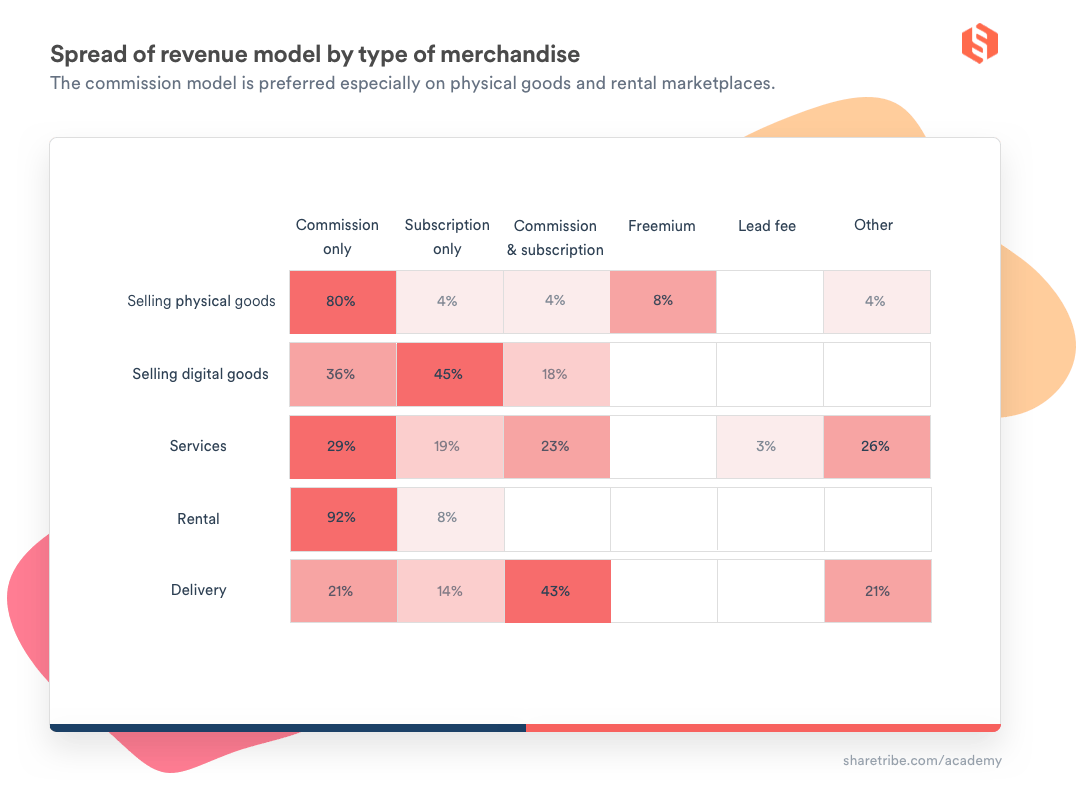
This article offers a full report of our research into the revenue strategies of the 100 best-performing marketplaces of last year.
In addition to marketplace types and revenue strategies, we analyzed the commission structure, fee size, fee distribution between sellers and providers, and strategies to communicate platform fees. The analyses offer insights that can support marketplace entrepreneurs in revenue strategy decisions. You can find more information on and access the data set used at the end of the article.
In our research, we identified four key learnings:
- At 33% and 26.6% of the platforms surveyed, service marketplaces and marketplaces selling physical goods are thriving. Delivery, rental, and digital goods marketplaces are also represented.
- Marketplace type affects the revenue models that work best. For product selling and rentals, a classic commission-only model is the most common choice, at 80% and 92% respectively. On service marketplaces, a wider distribution of revenue models shows that services are not as easily monetized through just one business model. Delivery marketplaces have a similar distribution of revenue models to service marketplaces. On digital goods marketplaces, subscriptions are popular.
- Your pricing should take into account the value you provide for your users and competitor pricing. While we saw stark differences in minimum commission and subscription prices, the marketplaces surveyed are also equally varied.
- Sellers are likely to pay commissions, while subscription payments usually fall to the buyers. If a marketplace monetizes both sides, the most common revenue model was commission and subscription combined. Often these are charged from different user groups.
We’ll dive deeper into each point in more detail below.
Different marketplace types were represented in the top 100 list quite evenly. At 33%, services is the most common merchandise type.
We suspect if we had done this research a few years earlier, this group would not have been in the lead. Designing a booking flow for a service marketplace can be a complex process. Development in software, together with customers' increased familiarity with marketplace platforms, can explain why service marketplaces have become commonplace in recent years.
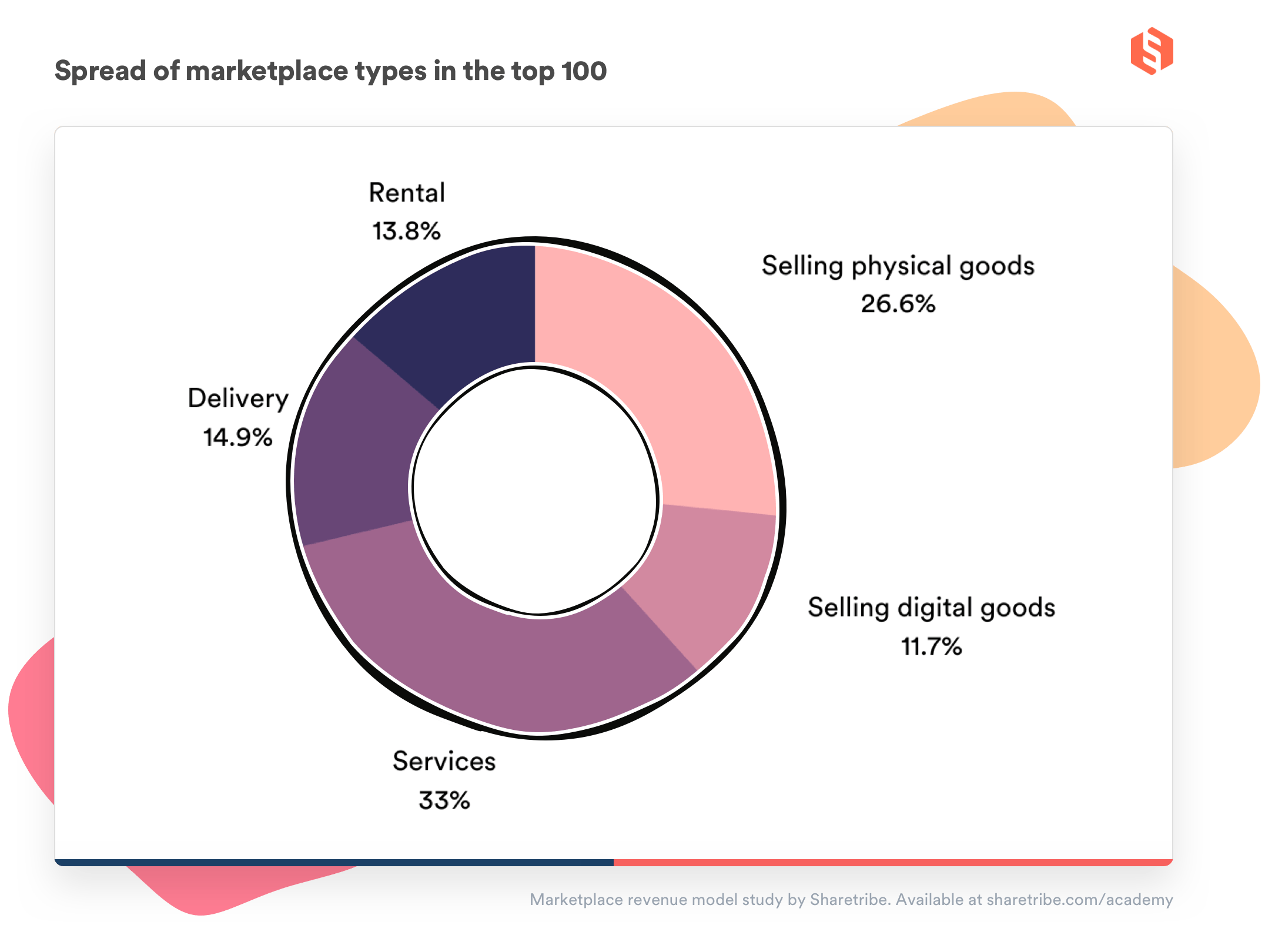
Physical product marketplaces are strongly represented at 26.6%, and over half of them are for selling pre-owned items. The second-hand market is growing rapidly, and we can see this in the Marketplace 100 ranking as well. The success of marketplaces like Vinted, Depop, and AptDeco prove that buying new is no longer the preferred option for many.
Another interesting finding is the number of delivery marketplaces like Instacart, Dumpling, and GrubMarket, which make up 14.9% of the marketplaces in the ranking. The key value these marketplaces offer is the delivery of consumable goods, not the goods themselves. The pandemic, no doubt, has had a large part to play in their recent growth. As Andreessen Horowitz's D'Arcy Coolican and Brandon Barros write in the a16z Marketplace 100 analysis: "how we eat 'out' and shop has changed dramatically over the past 12 months" – and now over the past two years.
Delivery marketplaces are, by nature, multi-sided. They need to attract not two but three user groups: buyers, sellers, and couriers. This often means multi-sided marketplaces have heavier budgetary needs than two-sided marketplaces. Marketing costs, competition for couriers and sellers, and demands from the software make delivery marketplaces less suited for bootstrapping. Investor-backed platforms tend to grow bigger faster.
Delivery is closely followed by rental marketplaces, at 13.8%, and marketplaces for selling digital goods close at 11.7%.
Among the top 100 marketplaces of 2021, the classic commission model reigns supreme.
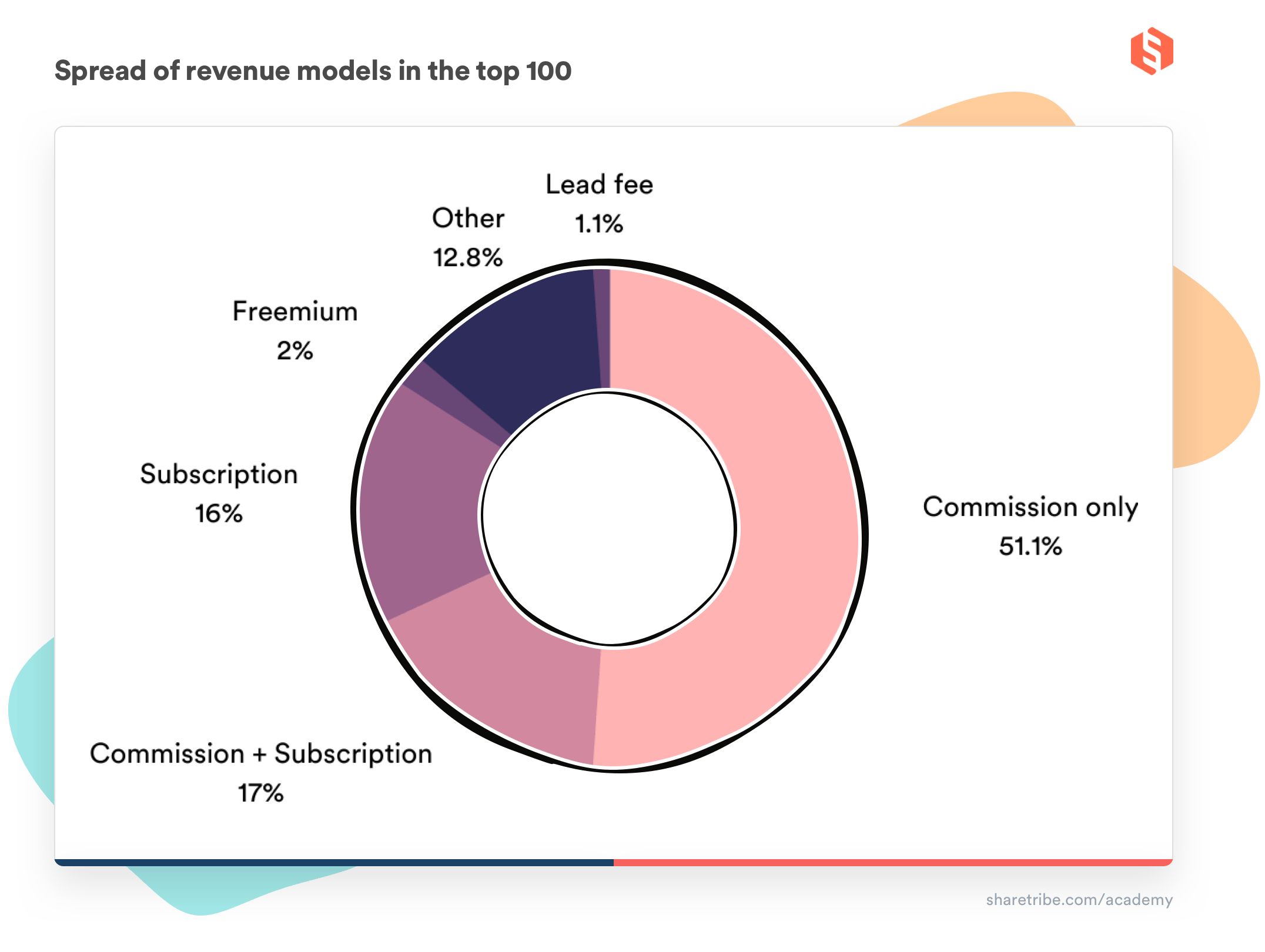
The popularity of the commission model is easy to explain, especially when the fee is charged from the sellers. The sellers pay commission when they make a sale, which means the marketplace is free to use until then. The platform only makes money if the seller does too. It’s unlikely the commission model will be replaced in popularity anytime soon.
Subscription is also a popular revenue model in the top 100, used in 33% of the marketplaces, either alone or combined with commission. The challenge of using a subscription model is providing enough value outside of facilitating transactions to justify a recurring payment.
A fairly large slice of the revenue models used is taken up by the category “Other”, which includes cases that are not easily classified. These marketplaces often use a combination of commission and a range of other fees, not all percentage-based. For example, Tophatter, a mobile discovery marketplace that hosts live auctions for physical goods, lists the following fees:
- Commission fee
- Scheduling fee
- Advertising fee
- Processing fee
- Several optional fees and potential penalties.
Complex pricing structures with multiple different revenue models allow marketplaces not to be dependent on just one revenue source or collect heavy fees from only one user side.
Our general recommendation for early-stage marketplaces is to start with one business model and then experiment and expand. Adding further services and fees can be a good idea after you have validated your business and built a solid user base. Exploring different revenue strategies usually requires technical resources and marketing support, which is why early-stage marketplaces often start with commission only.
Complex revenue structures can also be a form of friction. If a potential seller or customer finds it hard to discern how much they will eventually have to pay, they may take their business elsewhere.
We start to see stark differences in revenue model distribution when filtering by marketplace type. Selling products, offering services, or renting property are very different types of transactions, after all. The graph you saw at the beginning of the article shows that the ways to monetize them are varied as well.

Commissions-only makes up an 80% majority of revenue models on physical product marketplaces. This makes perfect sense. Selling a physical product is a straightforward, one-time purchase, ending with the item being picked up by or shipped to the buyer. If the goods are not consumables, people rarely need recurring delivery.
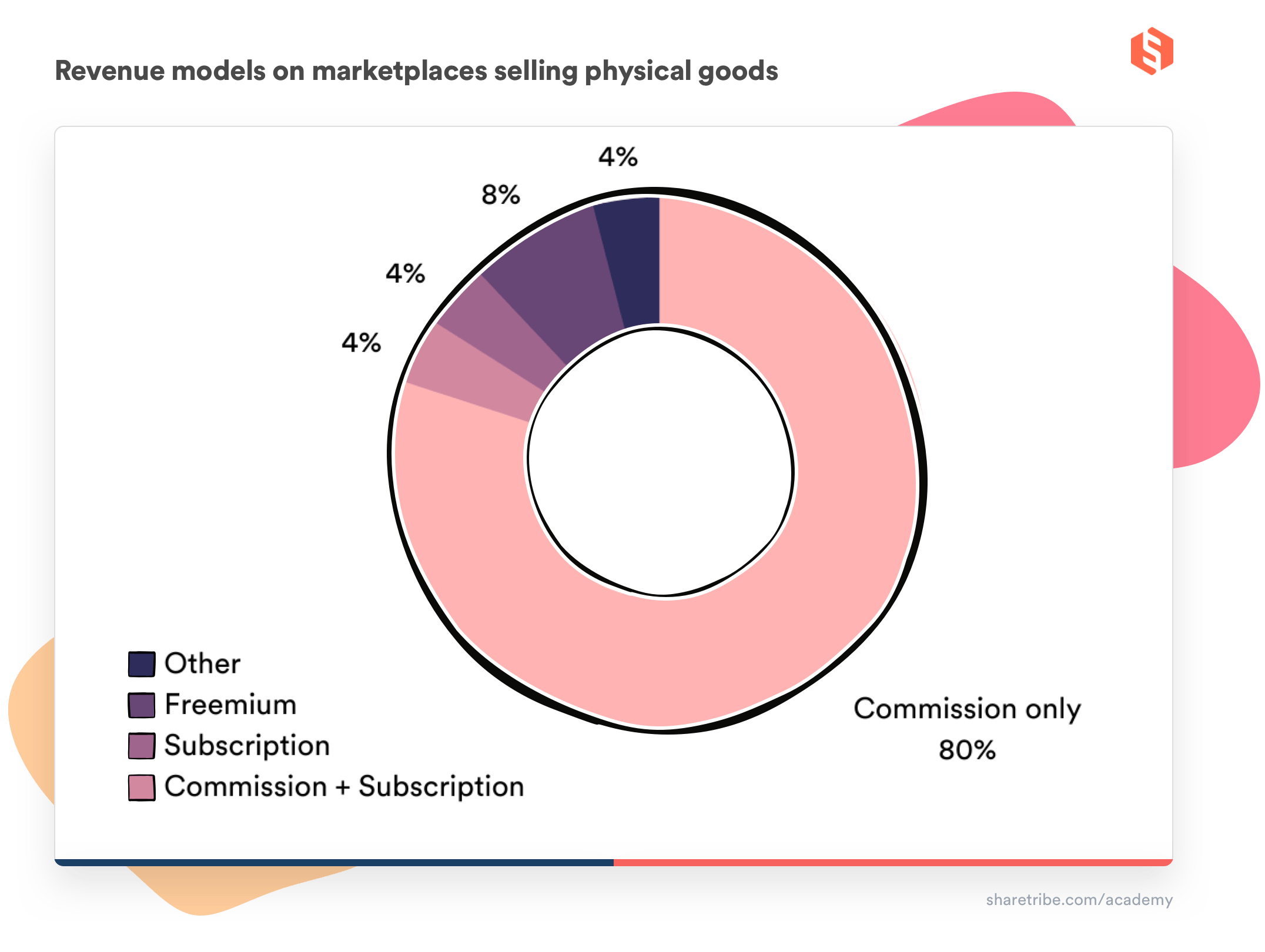
The sellers’ natural usage frequency on product marketplaces is often irregular. On second-hand fashion marketplaces like Vinted and Depop, the majority of sellers will likely only use the platform sporadically. While some expert thrifters have established stores on these platforms, most people sell second-hand clothes only at the end of a season or when a particular piece no longer feels right. A membership model does not match this type of user behavior.
Another commonality between these marketplaces is generally transparent pricing. Heavy competition is a likely explanation. Out of the 25 physical product marketplaces in the top 100, fourteen are for selling and buying preowned items. In this crowded space, having simple (and potentially more competitive) pricing can be a major success factor and even help carve out market share from big players.
An interesting case is the only physical product marketplace in the ranking that monetizes through the freemium model: Tundra. Tundra is a wholesale marketplace that “does not charge a fee, markup, or commission on orders between buyers and suppliers and never will”. Instead, they monetize by upselling a variety of additional services, ranging from expedited shipping to promotion.
A focus on digital products changes the revenue model distribution considerably.
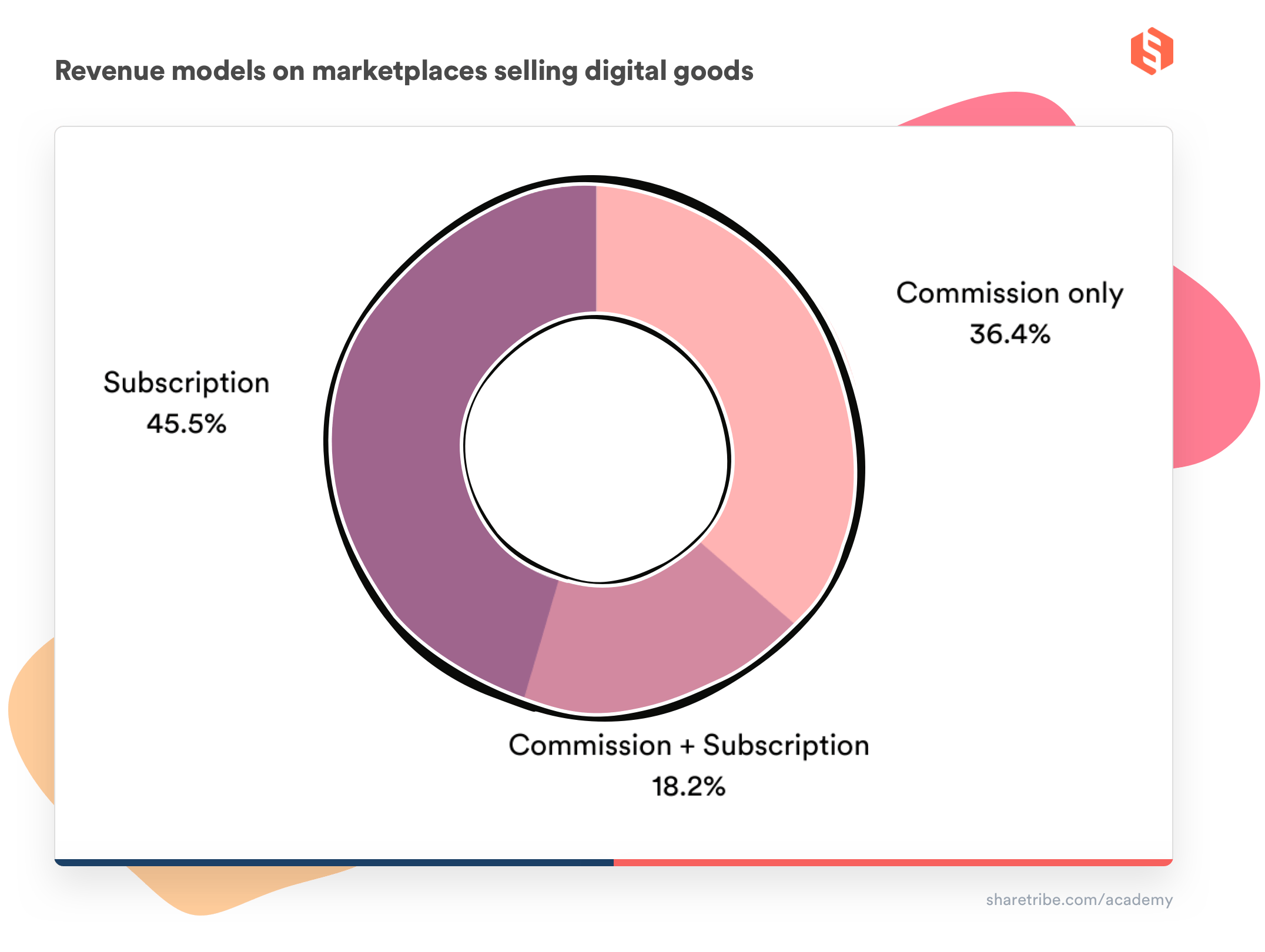
While the classic commission-only model is still used in over a third of the marketplaces, the most popular model is subscription at 45% – or 63% if we count in marketplaces that monetize through a combination of subscription and commission.
With digital goods, there are little to no reproduction costs per unit. Once a product is on the marketplace, it can theoretically be sold and consumed infinitely. This means access to distribution software and an existing audience can be valuable enough to justify a recurring subscription cost.
We also consume digital products differently from physical ones. If a marketplace charges a subscription from the buyers as well, it can let them consume the supply more freely. This requires a large quantity of quality content, however. MasterClass is a great example. They specialize in educational content from artists, scientists, and experts, many of who are well-known in traditional media. MasterClass doesn’t charge for courses individually, but subscription prices go up with the number of devices added to the subscription.
Looking at service marketplaces, commission-only no longer holds the number one spot. Instead, a combination of commission and subscription is the most commonly used revenue model, followed by “Other”.
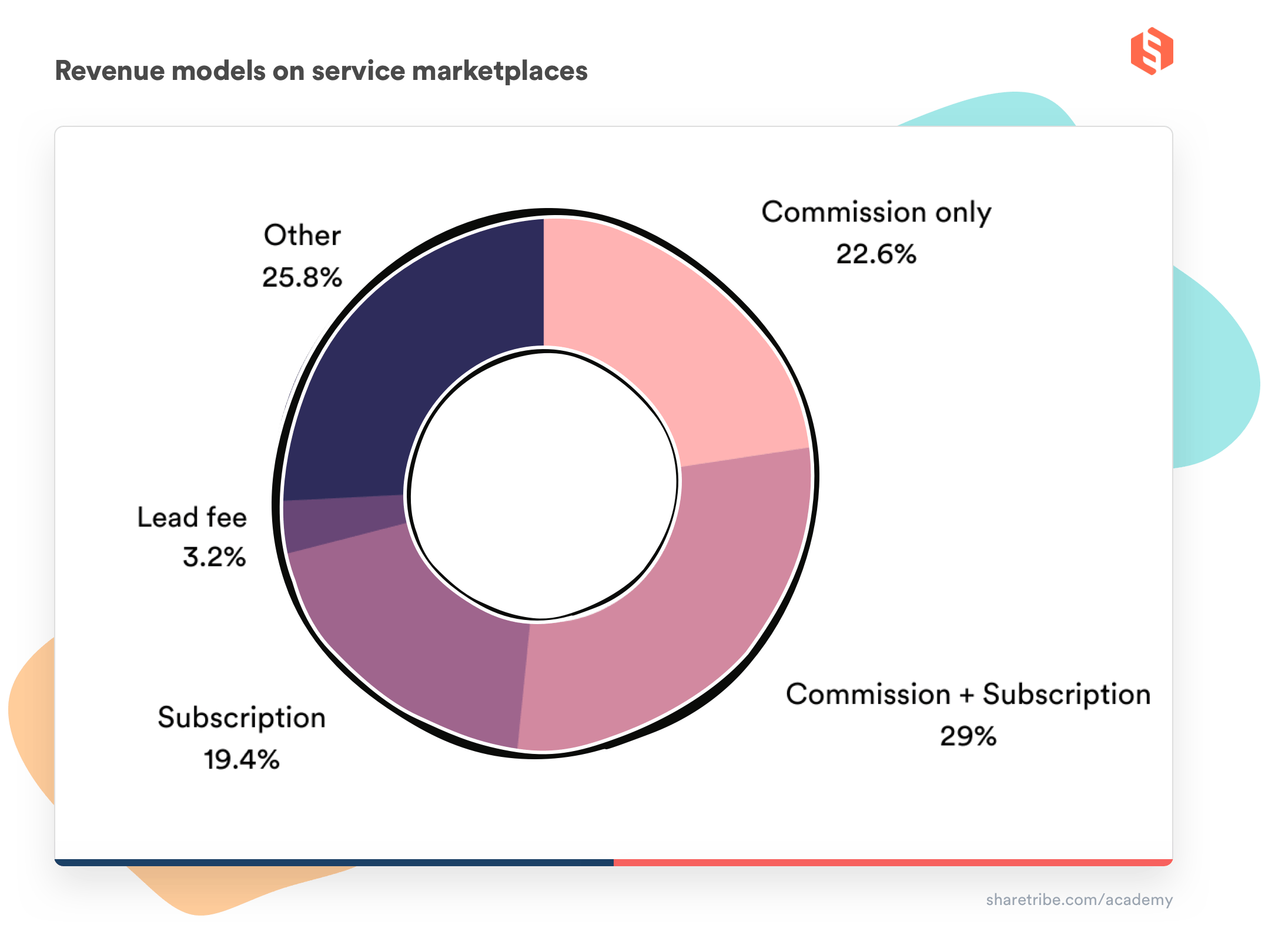
Buying a service tends to be a much more complex transaction than ordering a physical product, which may explain the smaller representation of the relatively straightforward commission-only model.
Service marketplaces in the top 100 ranking have a few ways to make the subscriptions model work.
Succeeding with the subscription model usually requires offering a lot of value besides the transaction. Having a strong software-as-a-service component is a typical example. The beauty, wellness, and fitness marketplace Vagaro, which monetizes through subscriptions only, offers a comprehensive set of scheduling and management tools for small businesses.
Subscriptions can also work on service marketplaces where the relationships between providers and customers are monogamous and ongoing. UrbanSitter, a marketplace for babysitting, charges a subscription from both providers and customers. The therapy marketplace TalkSpace offers buyers counseling sessions on a recurring subscription.
Our research also found several service marketplaces that use a larger combination of revenue models. These marketplaces are included in Other, at 26%.
A typical service marketplace in the Other category offers additional services or has a one-time setup fee. CoachUp, a marketplace for sports coaching services, charges a placement fee from customers when they get matched with a new coach. In addition, it collects a provider setup fee, commission, and subscription fee.
Some service marketplaces in the top 100 use lead fees as a part of their business model. The wedding platform Zola is an example. However, only one marketplace in the top 100 uses lead fees exclusively: Thumbtack.
Thumbtack is an outlier marketplace in other regards as well. Check out this article on how Thumbtack succeeded despite going against a lot of the general wisdom of marketplace startups. Notably, Thumbtack continues to succeed without making the expected move to a commission-based model.
We also noticed that service marketplaces were generally less transparent about their pricing. Many had no monetization or pricing information readily available.
Delivery marketplaces are similar to service marketplaces in revenue model distribution, which tracks with the provided value: delivery is, after all, a type of service.
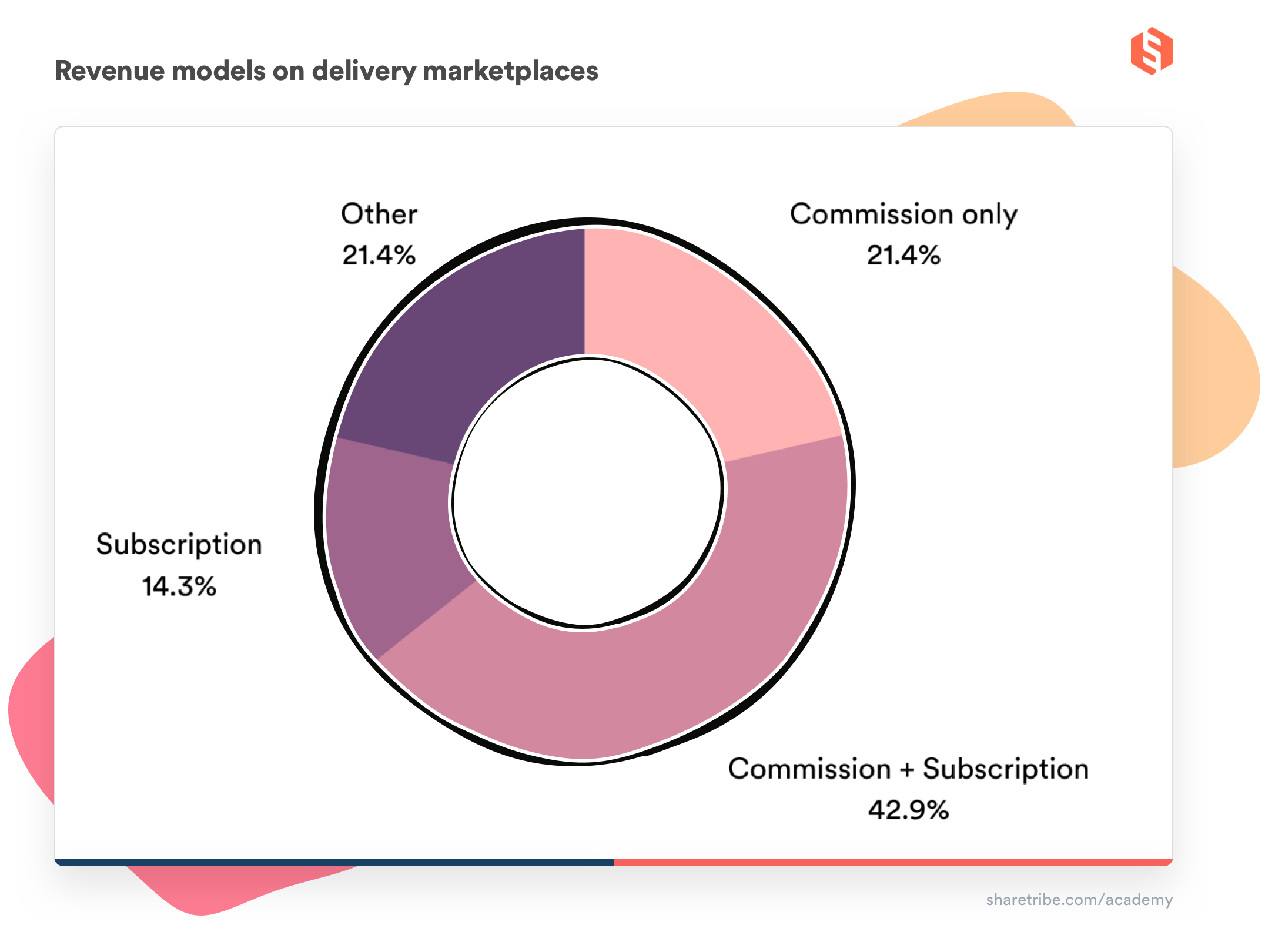
Since these marketplaces are multisided, finding conclusive pricing information was not always easy. When a buyer purchases a product from a seller and delivery from a courier, how much and which fee each party pays can get blurred. Delivery marketplaces that use non-commission revenue models (either instead of or to complement commissions) tend to have either courier or seller setup fees or buyer subscriptions.
Rental marketplaces in the top 100 are straightforward when it comes to monetization. Commissions on bookings is the clear business model of choice, with only one subscription-based rental marketplace, Harvest Hosts, breaking the mold.
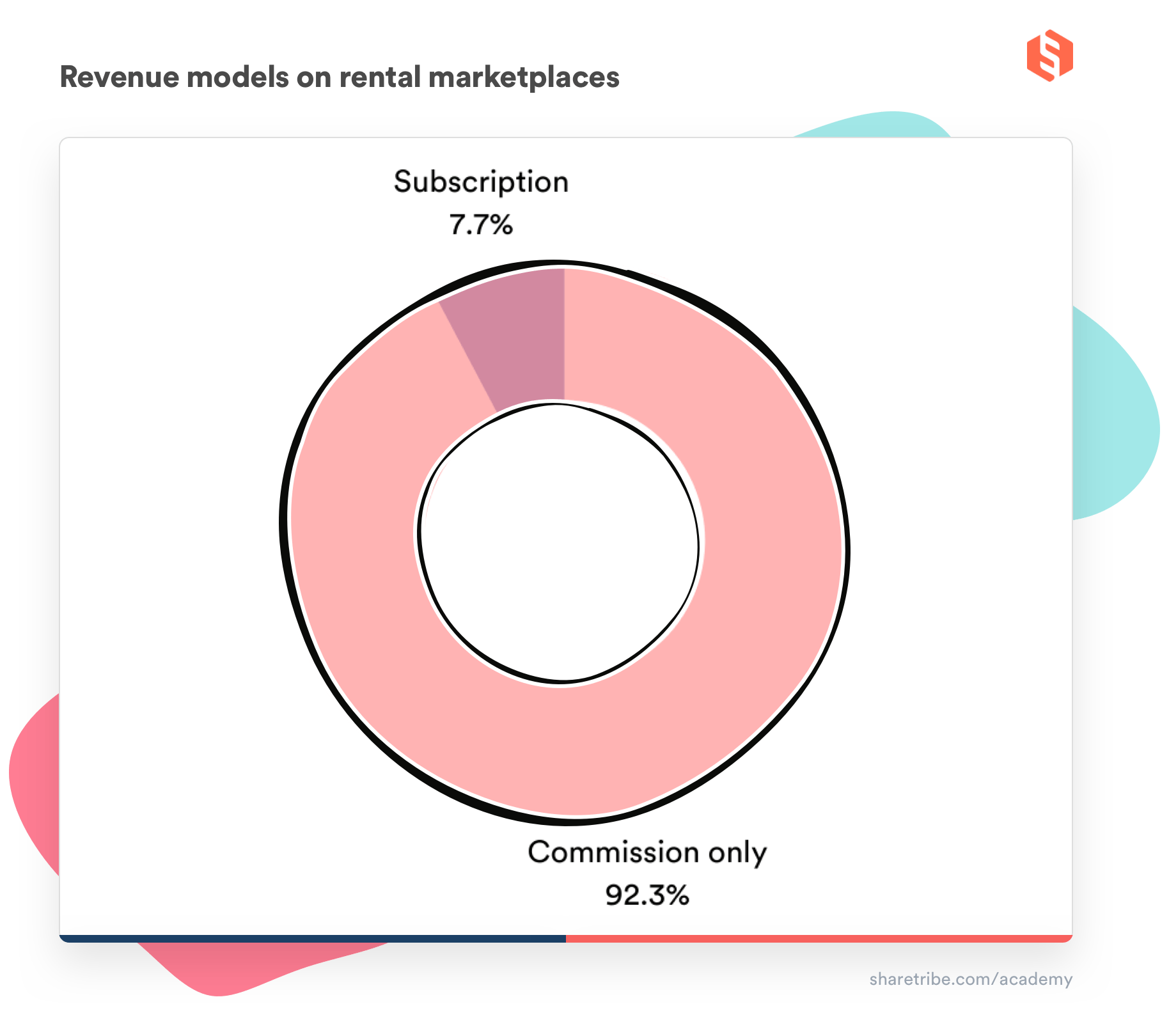
Harvest Hosts is a marketplace where the demand side, RV-owners, can find a place to camp their vehicle. The supply side, Hosts, consists of wineries, farms, and other attractions. RV-owners pay a yearly membership fee starting at $99, which grants them free overnight stays at all the Hosts’ venues. Hosts pay nothing to the platform. In exchange, the platform strongly suggests that the RV-owners “support their Hosts by purchasing one of their local products with each stay”.
Pricing on the top 100 marketplaces varies considerably. Commissions, for example, range from a few percent to 95%, but without the context of industry, competition, and marketplace type, this information is not particularly useful. We recommend benchmarking your specific competitors when deciding your marketplace’s pricing. Our data can offer a starting point for your research: for example, check how much the big players in your field are charging from this Airtable, where you access the data and do your own analysis.
The marketplace type with the most commission information available is marketplaces for physical goods. Minimum commissions on these platforms range from 8% to 20%. Notably, many marketplaces employ tiered pricing based on factors like seller standing (GOAT, 9.5%-25%), the number of previous items sold (StockX, 11%-12.5%), or item price (ThredUp, 20-95%). Tiered pricing can work if the price of items on your marketplace varies or you want to encourage seller retention in the face of heavy competition.
Similar to commissions, you should model potential subscription pricing based on the value you provide and the standards of your industry. Therapy marketplace Talkspace charges customers $276 a month, a high number when compared to other subscription-based marketplaces. However, therapy is a high-value, expert service, and compared to in-person counseling, Talkspace’s pricing is competitive. Vagaro charges providers a subscription on its business management tools on a pay-per-feature basis.
Subscription-based content marketplaces like MasterClass ($15/month paid annually) and Skillshare ($19/month or $8.25/month paid annually), on the other hand, compete not only with other similar marketplaces but streaming services in general. Their monthly subscription fees are close to other subscription-based streaming platforms.
The top 100 marketplaces operate in multiple different industries, so conclusive guidelines on how much to charge are difficult to formulate. When deciding your commission percentage or other pricing, we recommend benchmarking your competitors carefully. Generally, a good rule of thumb is to take as little as you need to sustainably run and grow your business.
In the top 100, by far most marketplaces charge their payments from their sellers.
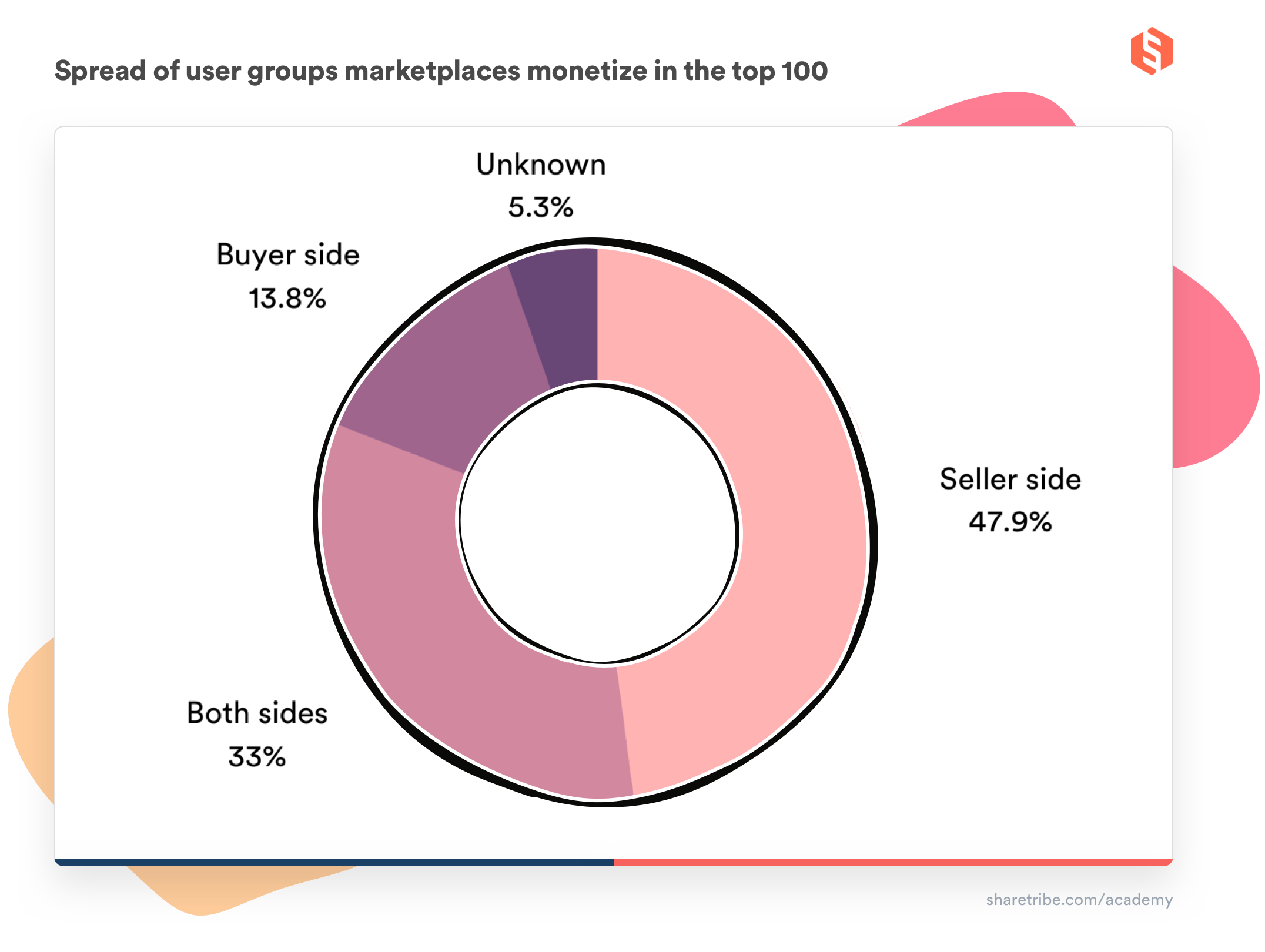
On almost 80% of the marketplaces in the top 100, sellers pay exclusively or partly. Buyers are charged less than 50% of the time, and only 13.8% of the marketplaces charge the demand side only.
Charging the supply side makes sense because sellers have an incentive to sign up and find potential customers. The marketplace’s and sellers’ goals are aligned: the platform only succeeds if its sellers succeed. It is also quite common to charge both buyers and sellers, for example, by collecting a subscription fee from one group and a commission from the other.
However, the situation changes when we filter the data by revenue model.
Commission-only marketplaces charge their sellers over 90% of the time. Buyers are very rarely the only ones who pay, while sellers foot the bill in 68.7% of the platforms.
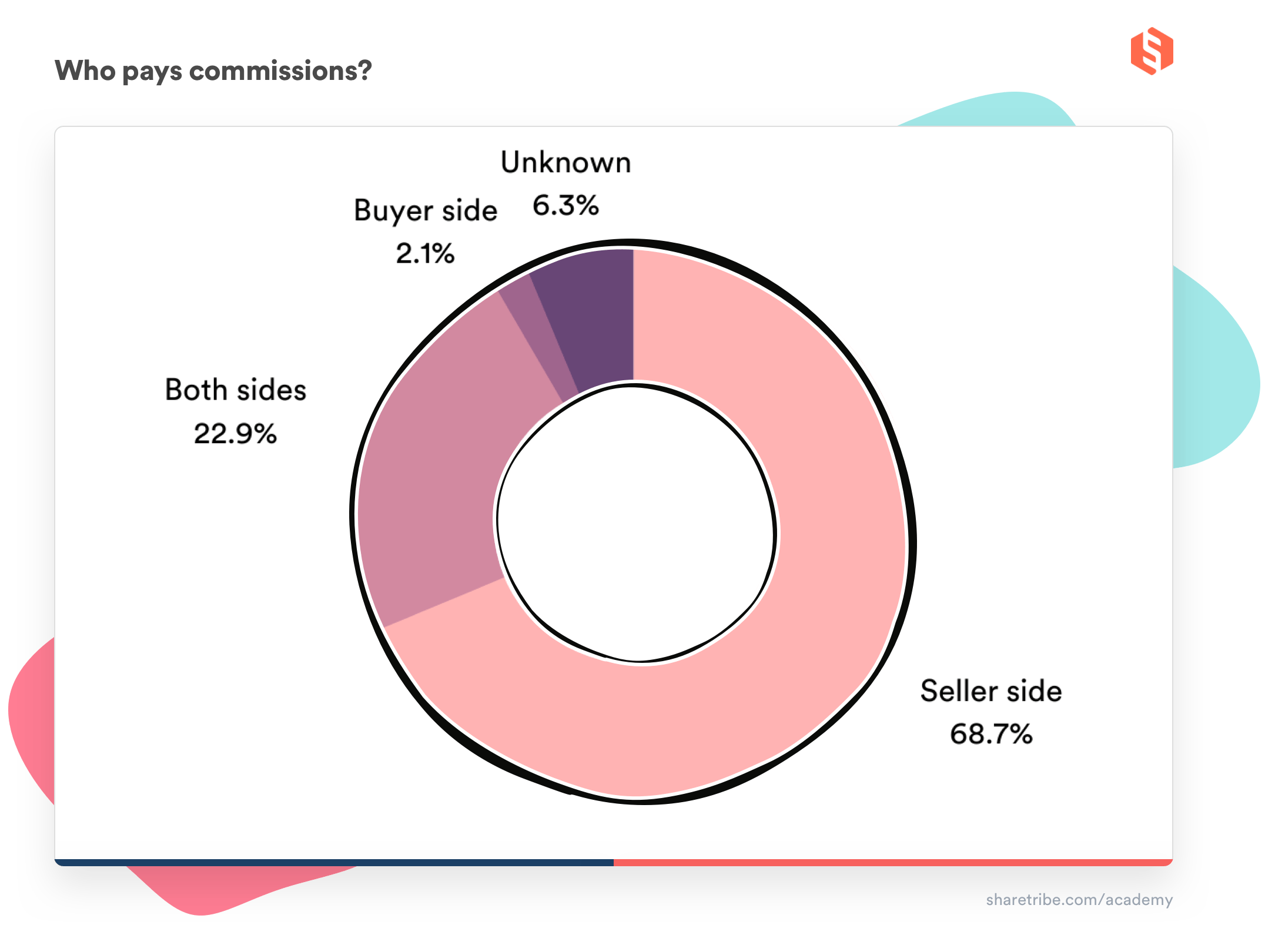
Still, sellers only pay commission fees when they sell something, so the barrier to adding their listings on these marketplaces remains low. Meanwhile, adding a buyer commission on top of the listing price can be a source of friction, especially if the commission comes as a surprise at checkout. Introducing such a fee might reduce the number of successful transactions and result in unhappy providers.
When a marketplace monetizes through subscriptions only, the situation changes drastically. On these marketplaces, buyers pay over 86.7% of the time and are the only ones charged 66.7% of the time.
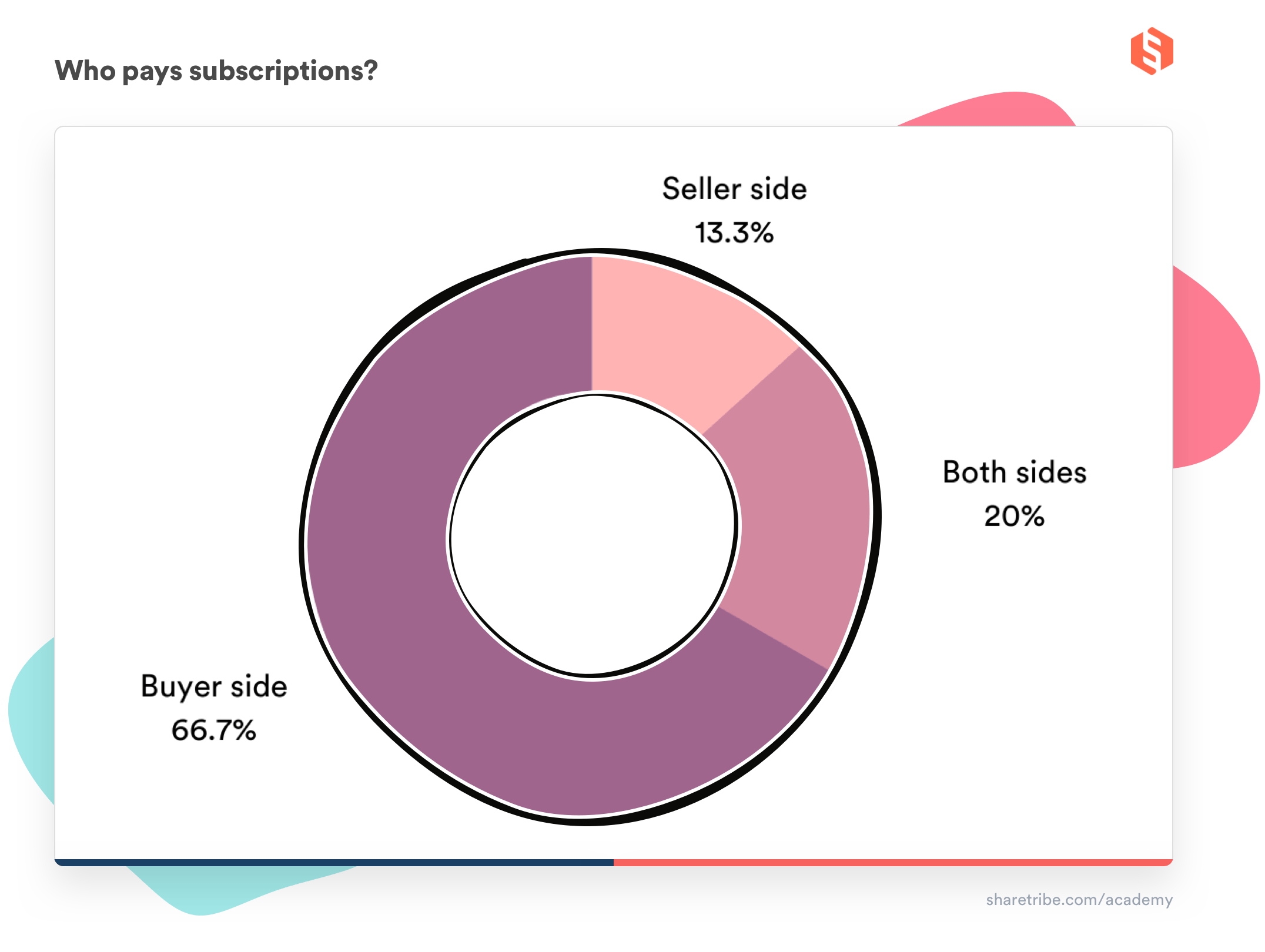
The subscription can be a recurring meal plan on a delivery marketplace (like Territory Foods and MealPal) or a recurring service like therapy (e.g. TalkSpace). Buyers get a lot of value from the marketplace, often for an extended period of time, without the need to look for another provider.
When sellers pay subscriptions, it is mainly for access to valuable tools. In addition to the afore-mentioned Vagaro, a great example is the music marketplace BeatStars. BeatStars offers different plans for sellers based on their feature requirements, but uploading music to the platform is free in the beginning.
When a marketplace uses a combination of subscription and commission fees, it often means one side pays a subscription and the other the commission.
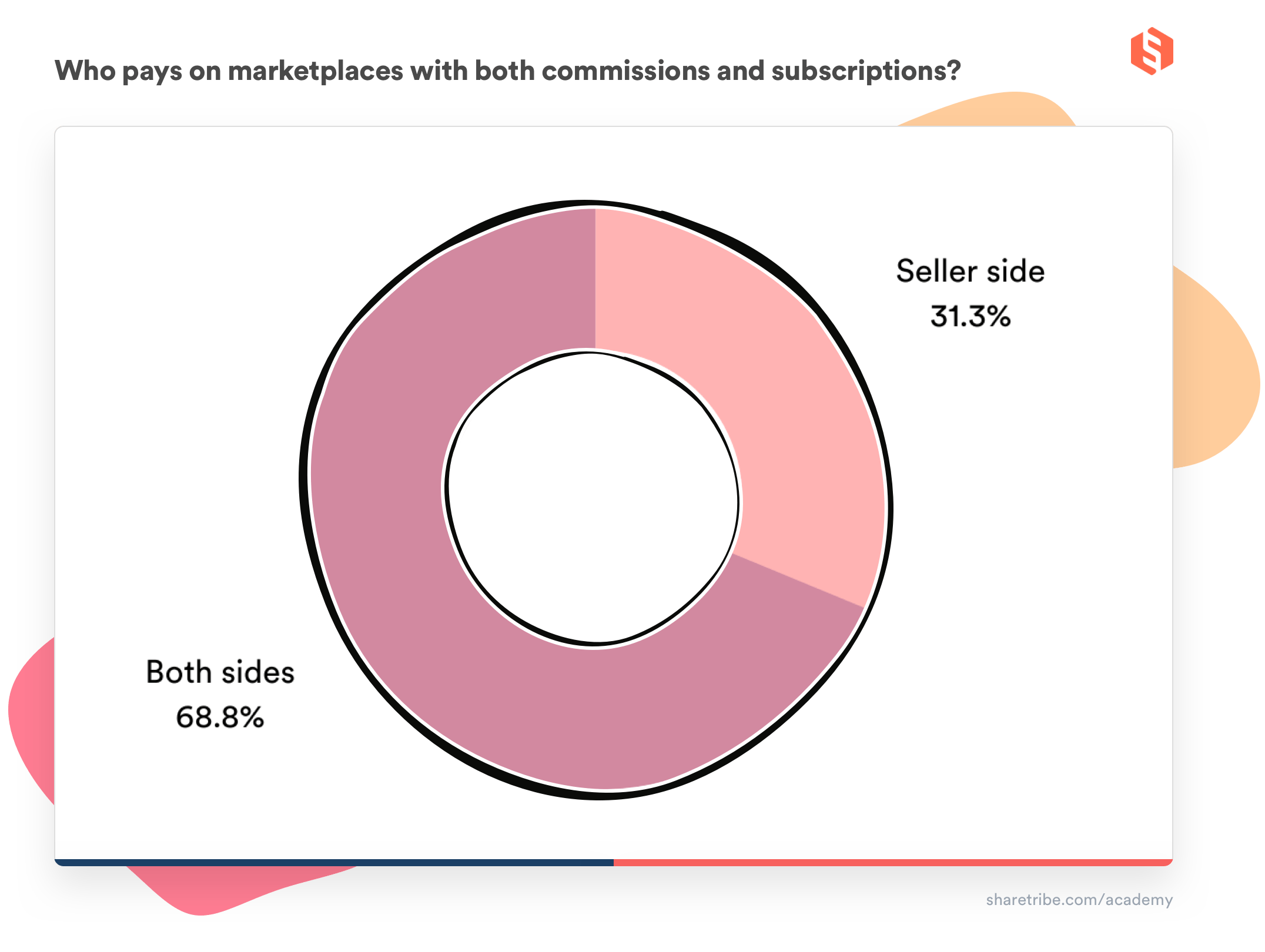
This is the case with marketplaces like Dumpling, where couriers or "shoppers" pay a subscription to access the platform's software, and customers pay a percentage-based fee in addition to delivery. On GrubMarket, buyers can buy groceries one-time or place a recurring order, while sellers pay a commission on these purchases. A service marketplace example is the health and massage marketplace Zeel. Its subscription fee pays for one monthly massage for the buyers, while providers pay a commission fee on the massage.
Word choice and branding are important to how a marketplace is monetized. Carefully considering what commissions are called on your marketplace can make a difference.
Among the top 100 marketplaces, some charge booking fees, while others have service or selling fees. All function as commissions, but they have different implications. A service fee is charged for the value provided to the user. A booking fee isn't just a general fee; it enables a specific type of purchase.
Another example is the difference between membership and subscription. While a subscription is paid for a service, a membership grants access to a community. If you're looking to turn your marketplace into a community and charge for access, word choice can make a subtle but important difference, even though in practice, subscription and membership can be the same thing.
Another key consideration is the accessibility of pricing information. On some marketplaces surveyed, this information was easy to find from help centers or pricing pages. On others, it took some searching. Some marketplaces had no pricing information available pre-signup.
As we've noted earlier in the analysis, product marketplace pricing was generally more accessible than service or delivery marketplace pricing. This can be explained, at least in part, by factors like the complexity of transactions and competition.
Still, it's worth noting that service marketplaces tend to be more crucial to their providers' livelihoods than product marketplaces. Providing services through these platforms can be the primary source of income for many, and the gig economy faces a lot of criticism about exploiting its workers. For a service provider, being able to evaluate your earning potential before joining a marketplace seems like a no-brainer, but this is not always possible. Transparency and fairness can be differentiating factors in competition against platform giants.
Another aspect to consider is that information can always be found, even if you don't share it yourself. Our research discovered information about earning potential sprinkled across publications and blog posts from current or past providers. Not all of this content was positive. Increasing competition will probably – and hopefully – make transparent provider policies a competitive necessity.
The goal of this marketplace revenue model study was to find parallels and look at the most common practices on successful platforms. Though some similarities can be identified, there are just as many, if not more, things that set these marketplaces apart. We should also note that a data set of 100 marketplaces is still relatively small for drawing definitive conclusions.
We hope the findings from this study inspire you to keep developing your marketplace pricing, experiment with marketplace business models, or continue to research the marketplaces that interest you. While following a trend to align with current standards can be a great idea, breaking the mold can be equally worthwhile. Perhaps your industry could do with a marketplace that offers a simpler revenue model than others. Or maybe adding some concierge marketplace services that justify higher commissions is just what some users are looking for.
In the end, each marketplace is unique. Their success is a result of many factors from pricing to marketing, execution to competition.
For the past two years, Andreessen Horowitz has been publishing Marketplace 100, "a ranking of the largest consumer-facing marketplace startups and private companies." The ranking provides insightful analyses on top-tier marketplace businesses: what categories are up-and-coming, which marketplaces are growing the fastest, GMV numbers, and so on. It's a fantastic effort by D'Arcy Coolican and Brandon Barros and well worth the read.
a16z's insight primarily focuses on aspects that interest their specific audience: investors and industry specialists. Sharetribe's focus is on marketplace founders, and we felt there were actionable findings to uncover in the ranking. We set out to find out what types of revenue models the top 100 marketplaces of 2021 use. What kind of marketplaces are they? If they charge a commission, how much do they take? And who pays the bill, providers or customers? Below, we elaborate on the categorization, our sources, and how you can access the data.
The data is structured around five types of marketplaces, based on their primary merchandise:
- Physical products: Supply consists of physical goods of finite quantity. Example: Vinted.
- Digital products: Supply consists of digital goods, and stock is theoretically infinite. Example: Envato.
- Rentals: Providers have an asset (usually high-value and underutilized) that they rent for set periods of time. Example: RVshare.
- Services: Providers have a skill and/or time that customers can acquire (teaching, dog-walking, etc.). Example: Wag!.
- Delivery: Purchases are delivered on-demand. Example: Mercato.
Five types of marketplace revenue models can be found among the top 100:
- Commission only: The platform charges a set fee or a percentage of the transaction value. Example: Boatsetter.
- Subscription or membership: One or both sides pay a subscription fee, and no transaction fees are collected. Example: Skillshare.
- Subscription + commission: A hybrid model of the above, where paid membership is used to monetize one or both sides of the marketplace while also collecting a commission on transactions. Example: StyleSeat.
- Lead fee: Customers post requests on the site, and providers pay to make a bid for these customers. Example: Thumbtack.
- Freemium: The platform and transactions are completely free. The marketplace monetizes by upselling optional, additional services. Example: Good Dog.
- Other: This category includes marketplaces that use a combination of multiple different revenue models or whose revenue model was unclear. While most of the marketplaces had readily available information on their pricing, some marketplaces were not transparent in this regard.
Two more revenue model options for marketplaces are listing fees (pay to add your product or service on a platform) and advertising. In the data, we did not find any platforms that used these as their main or only revenue source. If you want to learn more about all the ways to monetize your marketplace, check out our comprehensive article on marketplace business models to learn more!
On marketplaces, founders can choose to charge a fee from the sellers, buyers, or both. This can mean charging a commission from both parties, or maybe a subscription from one side and a lead fee from the other.
For some marketplaces in the top 100, we were unable to find conclusive answers on which side pays. These are categorized as "Unknown".
When collecting pricing data, we prioritized information found in the marketplaces' resources, such as help centers or pricing pages. On some of the marketplaces, detailed information about pricing was not publicly available. In these cases, we used reliable third-party articles as sources.
You can use our Google Data Studio report to look into the data we gathered. Use the filters to access insights most relevant for your business.
You can also browse the data in an Airtable of the entire revenue model data set.
Start your 14-day free trial
Create a marketplace today!
- Launch quickly, without coding
- Extend infinitely
- Scale to any size
No credit card required

